Numerical Prediction of Internal Flows in He/LOx Seals for Liquid Rocket Engine Cryogenic Turbopumps
Abstract
1. Introduction
2. Model Description
2.1. Mass Conservation Equations
2.2. Momentum Conservation Equations
2.3. Energy Conservation Equations of Fluid
2.4. Energy Conservation Equations of Solid
2.5. Heat Transfer Model
2.5.1. Fluid–Solid Heat Transfer
2.5.2. Solid–Solid Heat Transfer
2.6. Pressure Losses Model
2.6.1. Line Pressure Drop
2.6.2. Local Pressure Drop
2.7. Thermodynamic Properties and Equation of State
2.8. Nonlinear Solver
3. Dynamic Seal Package
3.1. DSP Model
3.2. Boundary Conditions
4. Results
4.1. Discussion
4.2. Model Validation
5. Conclusions
- A general-purpose finite volume procedure was implemented for solving the mass, momentum, and energy conservation equations of fluids and solids. The pressure drop and the convective single- and two-phase heat transfer, involved in the momentum and energy conservation equations, were calculated using empirical correlations.
- The network solver was based on an extension of a classic 1D homogeneous model, originally developed for a pure substance, to the case of two-phase multi-component flow. Classical two-phase heat transfer and pressure drop models were adapted to multi-component flows by using an overall gas fraction.
- The validation of the numerical tool was conducted by means of experimental data obtained for the secondary circuit of an oxidizer turbopump developed at Avio S.p.A.; the Dynamic Seal Package was considered, which includes leakage flow from the oxidizer pump discharge and mixing of the propellant with He.
- The numerical predictions of fluid temperatures were compared with the measured data. In most cases, a very good agreement was observed between the measurements and predictions, with a maximum error lower than , observed at the He/LOx drain.
- The temperature discrepancies may be due to several factors. The assumed homogeneous model and the adopted correlations may be inadequate to capture the two-phase phenomena of a bi-component mixture. However, the use of a more sophisticated model, such as the drift–flux model or two-fluid model, would imply a larger computational cost without guaranteeing a considerable accuracy improvement due to the implicit uncertainties in predicting the interfacial interaction terms between the two phases.
Author Contributions
Funding
Institutional Review Board Statement
Informed Consent Statement
Data Availability Statement
Conflicts of Interest
Nomenclature
| Symbols | |
| A | Branch area |
| Specific heat | |
| Hydraulic diameter | |
| Percentage error | |
| f | Darcy friction factor |
| g | Gravity acceleration |
| G | Mass flux |
| h | Enthalpy , heat transfer coefficient |
| Enthalpy of evaporation | |
| Equivalent enthalpy of evaporation | |
| k | Thermal conductibility |
| Rotation factor between fluid and surrounding surface (-) | |
| L | Branch length |
| m | Mass |
| Mass flow rate | |
| n | Number of elements in the network (-) |
| Number of fluid-to-fluid branches in the network (-) | |
| Number of fluid nodes in the network (-) | |
| Fluid nodes adjacent to node i (-) | |
| Number of fluid-to-solid branches in the network (-) | |
| Number of internal fluid nodes in the network (-) | |
| Number of species in the network (-) | |
| Number of solid-to-solid branches in the network (-) | |
| Number of solid nodes in the network (-) | |
| Solid nodes adjacent to node i (-) | |
| p | Pressure |
| Prandtl number (-) | |
| Heat flux | |
| Heat flux | |
| Reynolds number (-) | |
| T | Temperature (K) |
| t | Time |
| u | Velocity |
| V | Volume |
| x | Quality (-) |
| Greeks | |
| Mass fraction (-) | |
| Solid node distance | |
| Time interval between time steps | |
| Absolute roughness | |
| Branch inclination angle respect to gravity | |
| Viscosity | |
| Density | |
| Surface tension | |
| Molar fraction (-) | |
| Overall gas fraction (-) | |
| Angular velocity | |
| Subscripts and superscripts | |
| Annular flow | |
| Critical heat flux | |
| Dispersed flow | |
| Friction, fluid node variable (or unspecified) | |
| Fluid-to-fluid branch variable (or unspecified) | |
| Fluid-to-solid branch variable | |
| i | Node index |
| Branch index from node i to node j | |
| j | Node index adjacent to cell i |
| Branch index from node j to node i | |
| Specie, Local | |
| Saturated liquid, line | |
| Minimum heat flux | |
| Solid node variable | |
| Saturation condition | |
| Single-phase flow | |
| Solid-to-fluid branch variable | |
| solid-to-solid branch variable | |
| Two-phase flow | |
| t | Time step |
| New time step | |
| Upstream branch | |
| Saturated vapour | |
| Acronyms | |
| DSP | Dynamic Seal Package |
| He | Helium |
| LOx | Liquid oxygen |
| GN2 | Gaseous nitrogen |
References
- Sutton, G.P.; Biblarz, O. Rocket Propulsion Elements; Wiley: Hoboken, NJ, USA, 2017. [Google Scholar]
- Meyer, M.L.; Chato, D.J.; Plachta, D.W.; Zimmerli, G.A.; Barsi, S.J.; Van Dresar, N.T.; Moder, J.P. Mastering cryogenic propellants. J. Aerosp. Eng. 2013, 26, 343–351. [Google Scholar] [CrossRef]
- Lo, R.E. Modular Dissected Cryogenic Solid-Rocket Propellant Grains. Acta Astronaut. 2002, 51, 683–691. [Google Scholar] [CrossRef]
- Deng, B.; Yang, S.; Xie, X.; Wang, Y.; Pan, W.; Li, Q.; Gong, L. Thermal performance assessment of cryogenic transfer line with support and multilayer insulation for cryogenic fluid. Appl. Energy 2019, 250, 895–903. [Google Scholar] [CrossRef]
- Darr, S.; Dong, J.; Glikin, N.; Hartwig, J.; Majumdar, A.; Leclair, A.; Chung, J. The effect of reduced gravity on cryogenic nitrogen boiling and pipe chilldown. NPJ Microgravity 2016, 2, 16033. [Google Scholar] [CrossRef]
- Kumar, S.; Kwon, H.T.; Choi, K.H.; Lim, W.; Cho, J.H.; Tak, K.; Moon, I. LNG: An eco-friendly cryogenic fuel for sustainable development. Appl. Energy 2011, 88, 4264–4273. [Google Scholar] [CrossRef]
- Hartwig, J.; Darr, S.; Asencio, A. Assessment of existing two phase heat transfer coefficient and critical heat flux correlations for cryogenic flow boiling in pipe quenching experiments. Int. J. Heat Mass Transf. 2016, 93, 441–463. [Google Scholar] [CrossRef]
- Ishii, M.; Hibiki, T. Thermo-Fluid Dynamics of Two-Phase Flow; Springer: Berlin/Heidelberg, Germany, 2006. [Google Scholar]
- Liao, Z. Single Molecule Study of Photoconversion and Spectral Heterogeneities of Fluorophores. Ph.D. Thesis, Faculty of Science, University of Copenhagen, Kobenhavn, Denmark, 2014. [Google Scholar]
- Yuan, K.; Ji, Y.; Chung, J. Numerical modeling of cryogenic chilldown process in terrestrial gravity and microgravity. Int. J. Heat Fluid Flow 2009, 30, 44–53. [Google Scholar] [CrossRef]
- Wang, J.; Li, Y.; Wang, L.; Zhao, Y.; Ishii, M. Thermal prediction of transient two-phase flow in cryogenic transportation based on drift–flux model. Int. J. Heat Mass Transf. 2021, 177, 121512. [Google Scholar] [CrossRef]
- Li, C.; Li, Y.; Cheng, Y.; Chen, E.; Liu, Z.; Wang, J. Transient characteristics and performances of passive recirculation system for liquid rocket engine precooling. Appl. Therm. Eng. 2019, 149, 41–53. [Google Scholar] [CrossRef]
- Hooser, K.V.; Bailey, J.; Majumdar, A. Numerical prediction of transient axial thrust and internal flows in a rocket engine turbopump. In Proceedings of the 35th Joint Propulsion Conference and Exhibit, Los Angeles, CA, USA, 20–24 June 1999. [Google Scholar]
- Majumdar, A. Generalized Fluid System Simulation Program, Version 6.0. 2013. Available online: https://ntrs.nasa.gov/api/citations/20140003178/downloads/20140003178.pdf (accessed on 1 January 2022).
- Hu, H.; Chung, J.N.; Amber, S.H. An experimental study on flow patterns and heat transfer characteristics during cryogenic chilldown in a vertical pipe. Cryogenics 2012, 52, 268–277. [Google Scholar] [CrossRef]
- Johnson, J.; Shine, S. Transient cryogenic chill down process in horizontal and inclined pipes. Cryogenics 2015, 71, 7–17. [Google Scholar] [CrossRef]
- Darr, S.; Hu, H.; Glikin, N.; Hartwig, J.; Majumdar, A.; Leclair, A.; Chung, J. An experimental study on terrestrial cryogenic tube chilldown II. Effect of flow direction with respect to gravity and new correlation set. Int. J. Heat Mass Transf. 2016, 103, 1243–1260. [Google Scholar] [CrossRef]
- Hartwig, J.; Styborski, J.; McQuillen, J.; Rame, E.; Chung, J. Liquid hydrogen line chilldown experiments at high Reynolds Numbers. Optimal chilldown methods. Int. J. Heat Mass Transf. 2019, 137, 703–713. [Google Scholar] [CrossRef]
- Jin, L.; Park, C.; Cho, H.; Lee, C.; Jeong, S. Experimental investigation on chill-down process of cryogenic flow line. Cryogenics 2016, 79, 96–105. [Google Scholar] [CrossRef]
- Jin, L.; Lee, J.; Jeong, S. Investigation on heat transfer in line chill-down process with various cryogenic fluids. Int. J. Heat Mass Transf. 2020, 150, 119204. [Google Scholar] [CrossRef]
- Shaeffer, R.; Hu, H.; Chung, J. An experimental study on liquid nitrogen pipe chilldown and heat transfer with pulse flows. Int. J. Heat Mass Transf. 2013, 67, 955–966. [Google Scholar] [CrossRef]
- Hartwig, J.W.; Rame, E.; McQuillen, J. Pulse chilldown tests of a tank-to-tank liquid hydrogen propellant transfer line. In Proceedings of the 54th AIAA Aerospace Sciences Meeting, San Diego, CA, USA, 4–8 January 2016; p. 2186. [Google Scholar]
- Hu, H.; Wijeratne, T.K.; Chung, J.N. Two-Phase Flow and Heat Transfer during Chilldown of a Simulated Flexible Metal Hose Using Liquid Nitrogen. J. Low Temp. Phys. 2013, 174, 247–268. [Google Scholar] [CrossRef]
- Chung, J.; Darr, S.; Dong, J.; Wang, H.; Hartwig, J. Heat transfer enhancement in cryogenic quenching process. Int. J. Therm. Sci. 2020, 147, 106117. [Google Scholar] [CrossRef]
- Kim, S.M.; Mudawar, I. Review of databases and predictive methods for heat transfer in condensing and boiling mini/micro-channel flows. Int. J. Heat Mass Transf. 2014, 77, 627–652. [Google Scholar] [CrossRef]
- Mazzei, L.; Marin, F.M.; Bianchini, C.; Soghe, R.D.; Bertani, C.; Pastrone, D.; Angelucci, M.; Caggiano, G.; de Beer, M. Analysis of a Stator-Rotor-Stator Spinning Disk Reactor in Single-Phase and Two-Phase Boiling Conditions Using a Thermo-Fluid Flow Network and CFD. Fluids 2022, 7, 42. [Google Scholar] [CrossRef]
- Dittus, F.; Boelter, L. Heat transfer in automobile radiators of the tubular type. Int. Commun. Heat Mass Transf. 1985, 12, 3–22. [Google Scholar] [CrossRef]
- Wang, J.; Li, Y.; Wang, L.; Zhu, K.; Xie, F.; Li, C. Transient modeling of cryogenic two-phase flow boiling during chill-down process. Appl. Therm. Eng. 2018, 143, 461–471. [Google Scholar] [CrossRef]
- Hill, W.S.; Rohsenow, W.M. Dryout Droplet Distribution and Disperse Flow Film Boiling; Technical Report 85694-105; Massachusetts Institute of Technology: Cambridge, MA, USA, 1982. [Google Scholar]
- Bromley, L.A. Heat Transfer in Stable Film Boiling; US Atomic Energy Commission, Technical Information Division: Washington, DC, USA, 1949; Volume 2295.
- Zuber, N.; Fried, E. Two-phase flow and boiling heat transfer to cryogenic liquids. ARS J. 1962, 32, 1332–1340. [Google Scholar] [CrossRef]
- Darr, S.R.; Dong, J.; Glikin, N.; Hartwig, J.W.; Chung, J.N. Rewet Temperature Correlations for Liquid Nitrogen Boiling Pipe Flows Across Varying Flow Conditions and Orientations. J. Therm. Sci. Eng. Appl. 2019, 11, 051008. [Google Scholar] [CrossRef]
- Kalinin, E.K.; Yarkho, S.A.; Berlin, I.I.; Kochelaev, Y.S.; Kostyuk, V.V. Investigation of the boiling crisis and heat transfer in dispersed-film boiling of liquids in channels. Heat Transfer. Soviet Res. 1987, 19, 1. [Google Scholar]
- Colebrook, C.F. Turbulent Flow in Pipes, With Particular Reference to the Transition Region Between the Smooth and Rough Pipe Laws. J. Inst. Civ. Eng. 1939, 11, 133–156. [Google Scholar] [CrossRef]
- Qi, S.; Zhang, P.; Wang, R.; Xu, L. Single-phase pressure drop and heat transfer characteristics of turbulent liquid nitrogen flow in micro-tubes. Int. J. Heat Mass Transf. 2007, 50, 1993–2001. [Google Scholar] [CrossRef]
- Zhang, P. Flow and Heat Transfer Characteristics of Liquid Nitrogen in Mini-/Microchannels. Heat Transf. Eng. 2013, 34, 204–212. [Google Scholar] [CrossRef]
- Chen, X.; Hou, Y.; Chen, S.; Liu, X.; Zhong, X. Characteristics of frictional pressure drop of two-phase nitrogen flow in horizontal smooth mini channels in diabatic/adiabatic conditions. Appl. Therm. Eng. 2019, 162, 114312. [Google Scholar] [CrossRef]
- Yun, J.H.; Jeong, J.H. A Review of Prediction Methods for Two-Phase Pressure Loss in Mini/Micro-Channels. Int. J.-Air-Cond. Refrig. 2016, 24, 1630002. [Google Scholar] [CrossRef]
- Qi, S.; Zhang, P.; Wang, R.; Xu, L. Flow boiling of liquid nitrogen in micro-tubes: Part I—The onset of nucleate boiling, two-phase flow instability and two-phase flow pressure drop. Int. J. Heat Mass Transf. 2007, 50, 4999–5016. [Google Scholar] [CrossRef]
- Chen, G.F.; Gong, M.; Wang, S.; Wu, J.F.; Zou, X.; Sun, Z. Two-phase frictional pressure drop of methane in a horizontal tube: Experimental investigation and comparison with correlations. AIP Conf. Proc. 2012, 1434, 1051. [Google Scholar]
- Chen, D.; Shi, Y. Study on two-phase pressure drop of LNG during flow boiling in a 8 mm horizontal smooth tube. Exp. Therm. Fluid Sci. 2014, 57, 235–241. [Google Scholar] [CrossRef]
- Friedel, L. Improved Friction Pressure Drop Correlation for Horizontal and Vertical Two-Phase Pipe Flow. In Proceedings of the European-American-Japanese Two-Phase Flow Group Meeting, Ispra, Italy, 5–8 June 1979. [Google Scholar]
- Müller-Steinhagen, H.; Heck, K. A simple friction pressure drop correlation for two-phase flow in pipes. Chem. Eng. Process. Process. Intensif. 1986, 20, 297–308. [Google Scholar] [CrossRef]
- Idelchik, I.E. Handbook of Hydraulic Resistance; CRC Press: Boca Raton, FL, USA, 1994. [Google Scholar]
- Bell, I.H.; Wronski, J.; Quoilin, S.; Lemort, V. Pure and Pseudo-pure Fluid Thermophysical Property Evaluation and the Open-Source Thermophysical Property Library CoolProp. Ind. Eng. Chem. Res. 2014, 53, 2498–2508. [Google Scholar] [CrossRef]
- Galántai, A. The theory of Newton’s method. J. Comput. Appl. Math. 2000, 124, 25–44. [Google Scholar] [CrossRef]
- Broyden, C.G. A class of methods for solving nonlinear simultaneous equations. Math. Comput. 1965, 19, 577–593. [Google Scholar] [CrossRef]
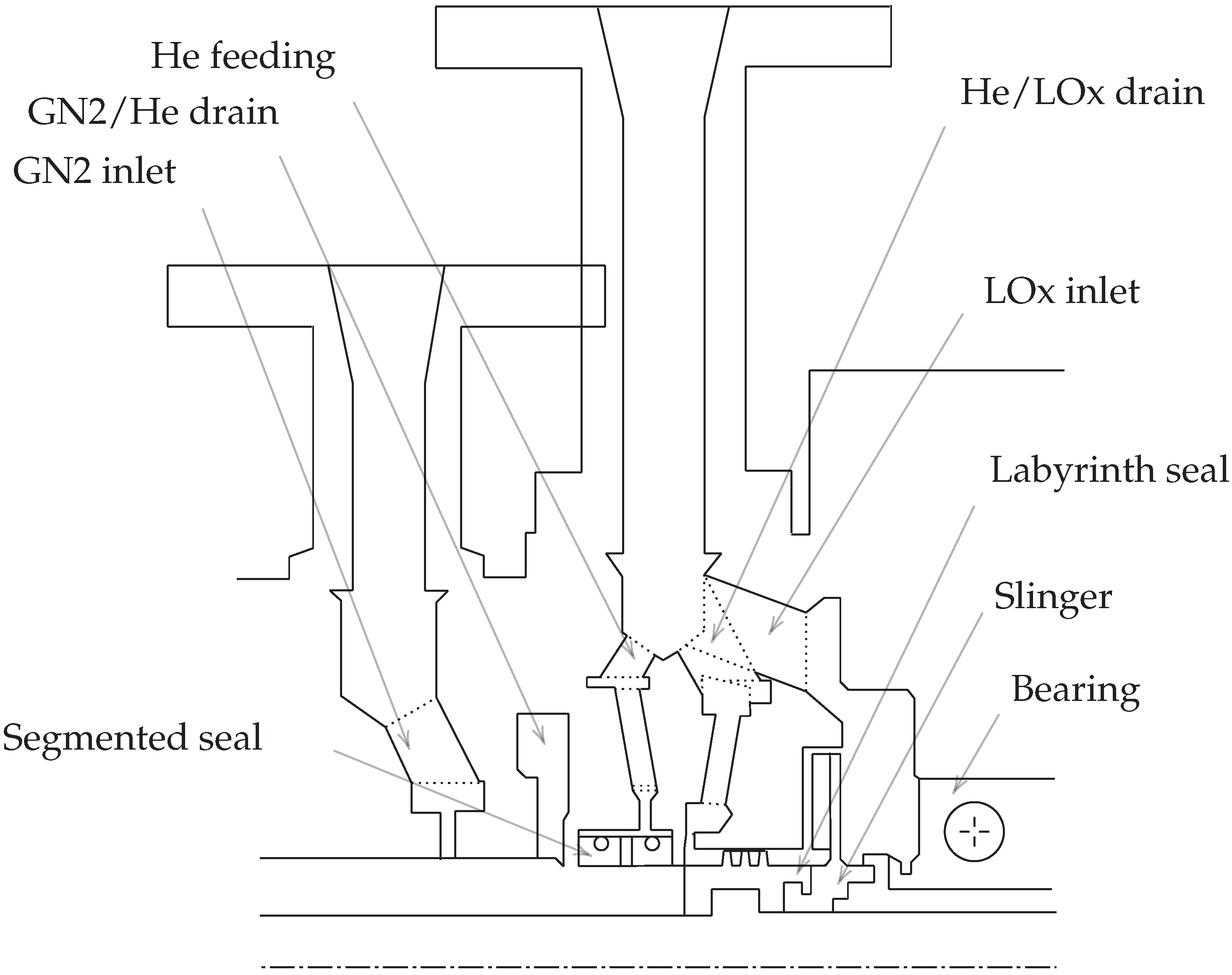


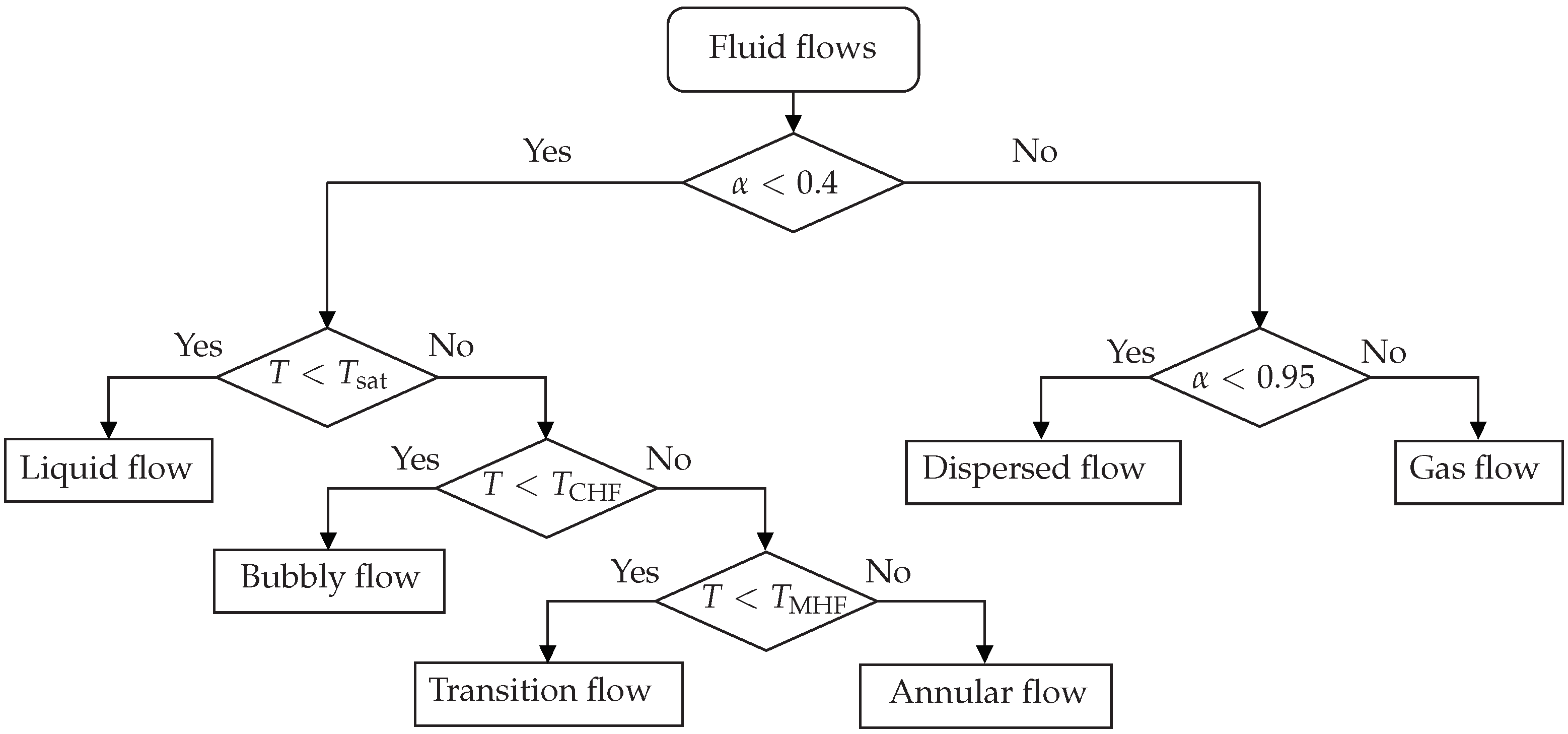

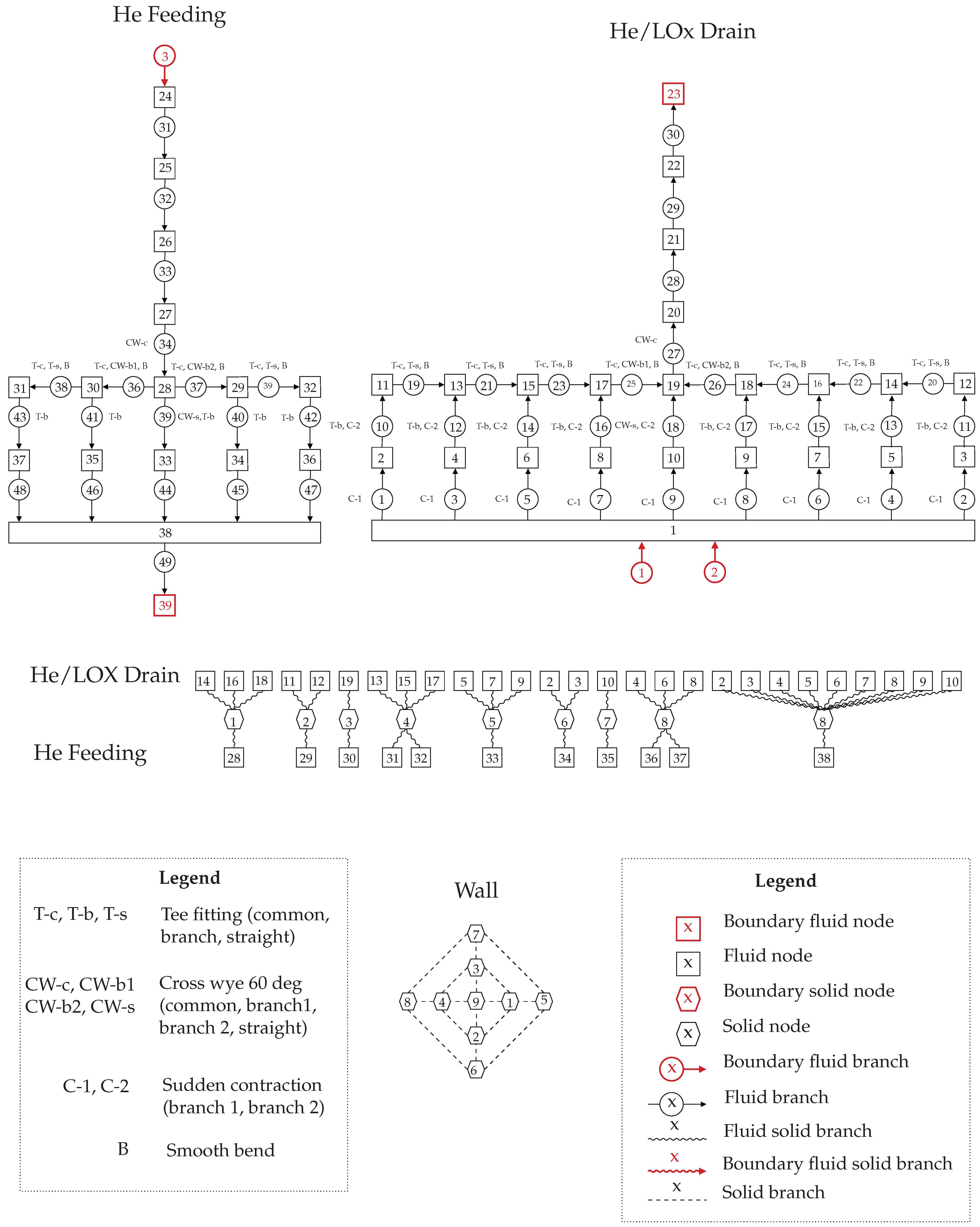

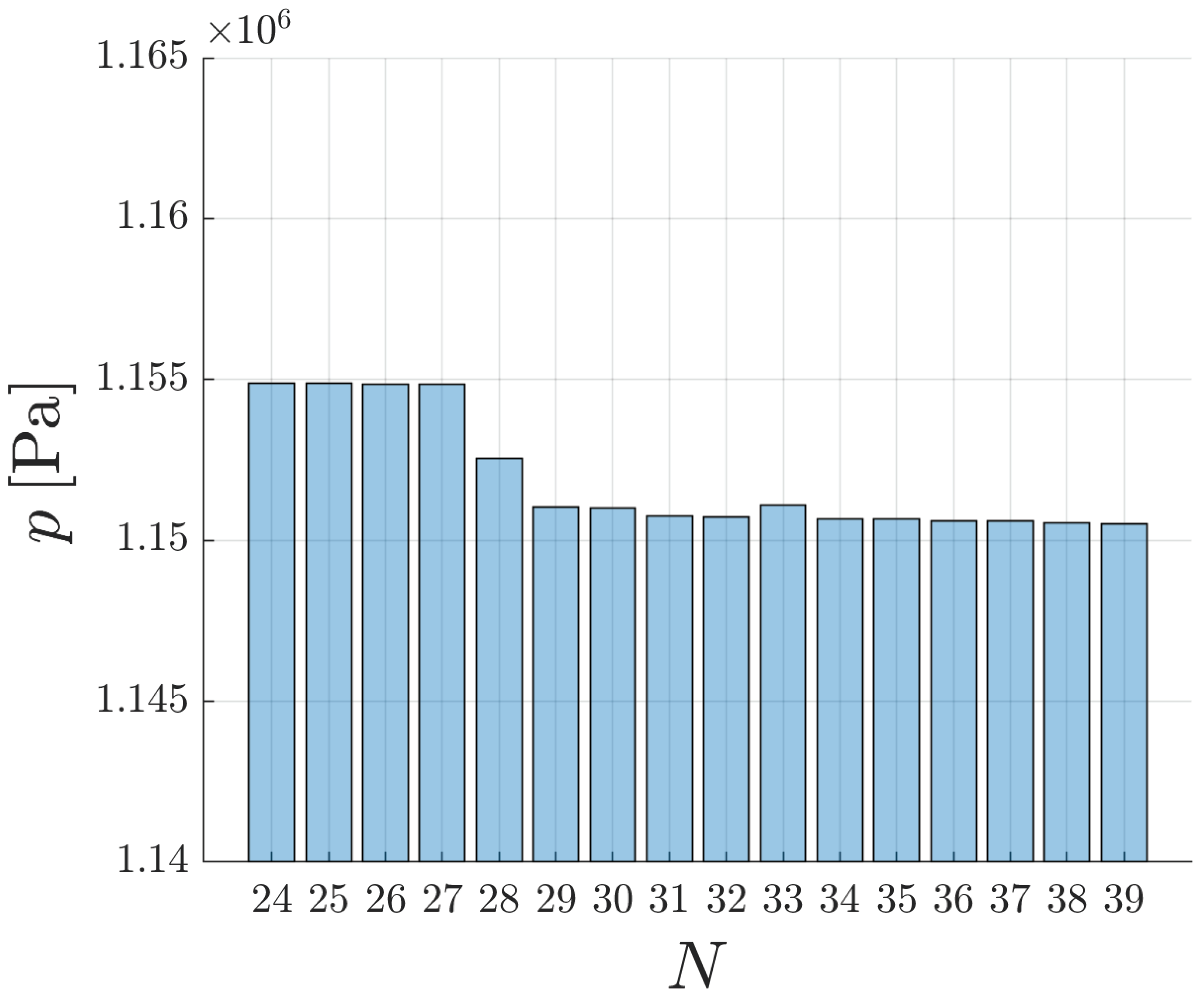
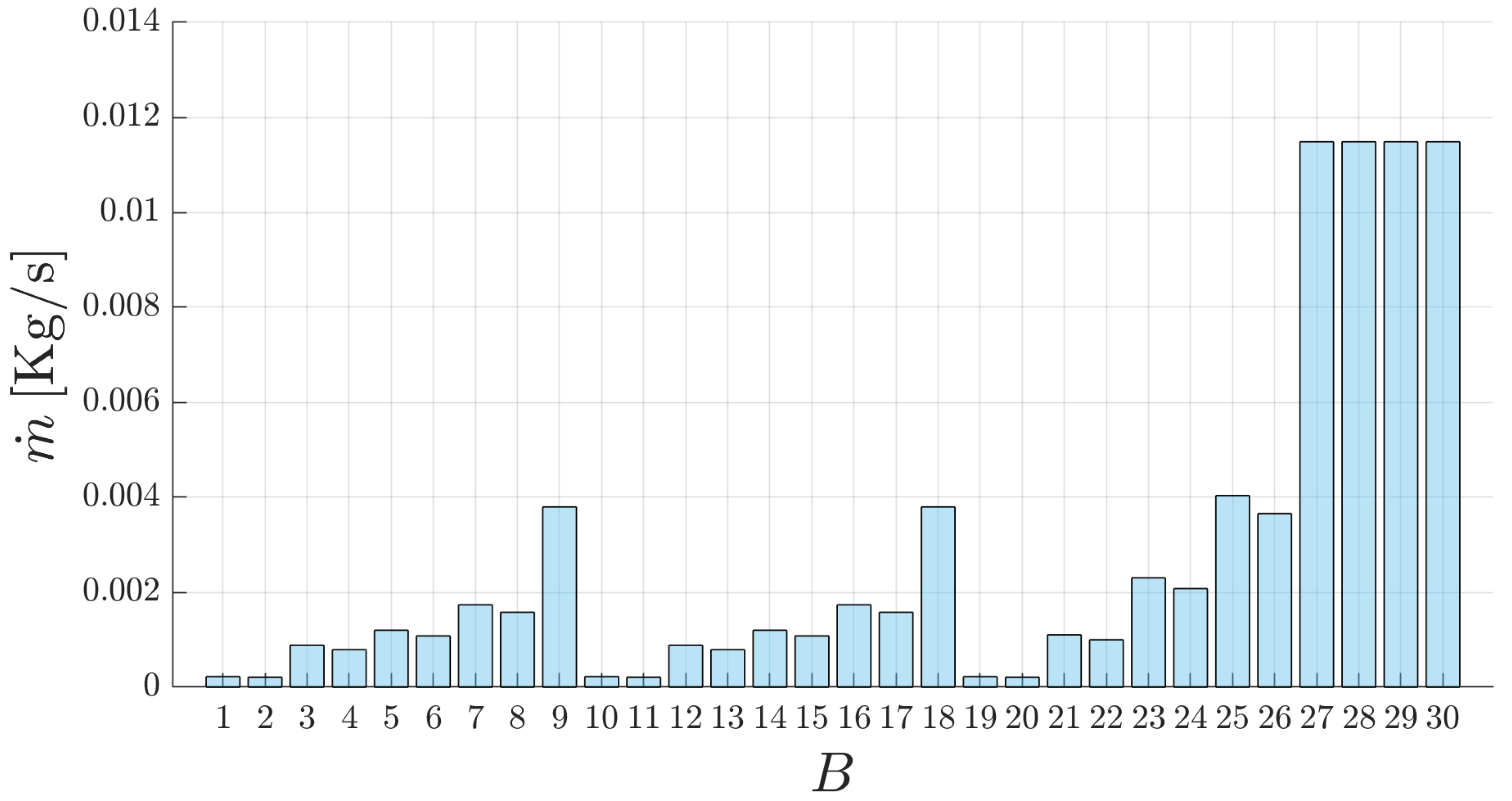
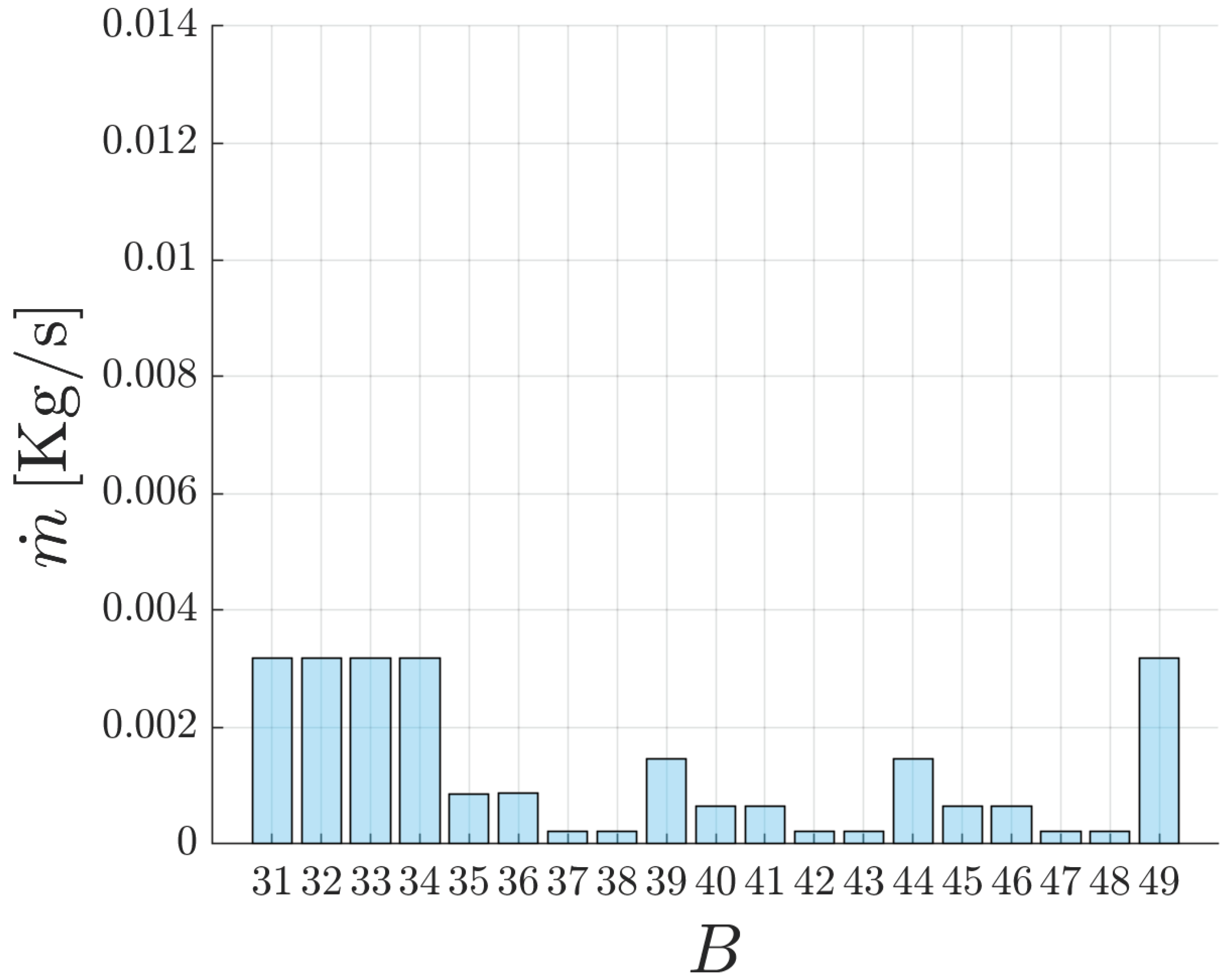
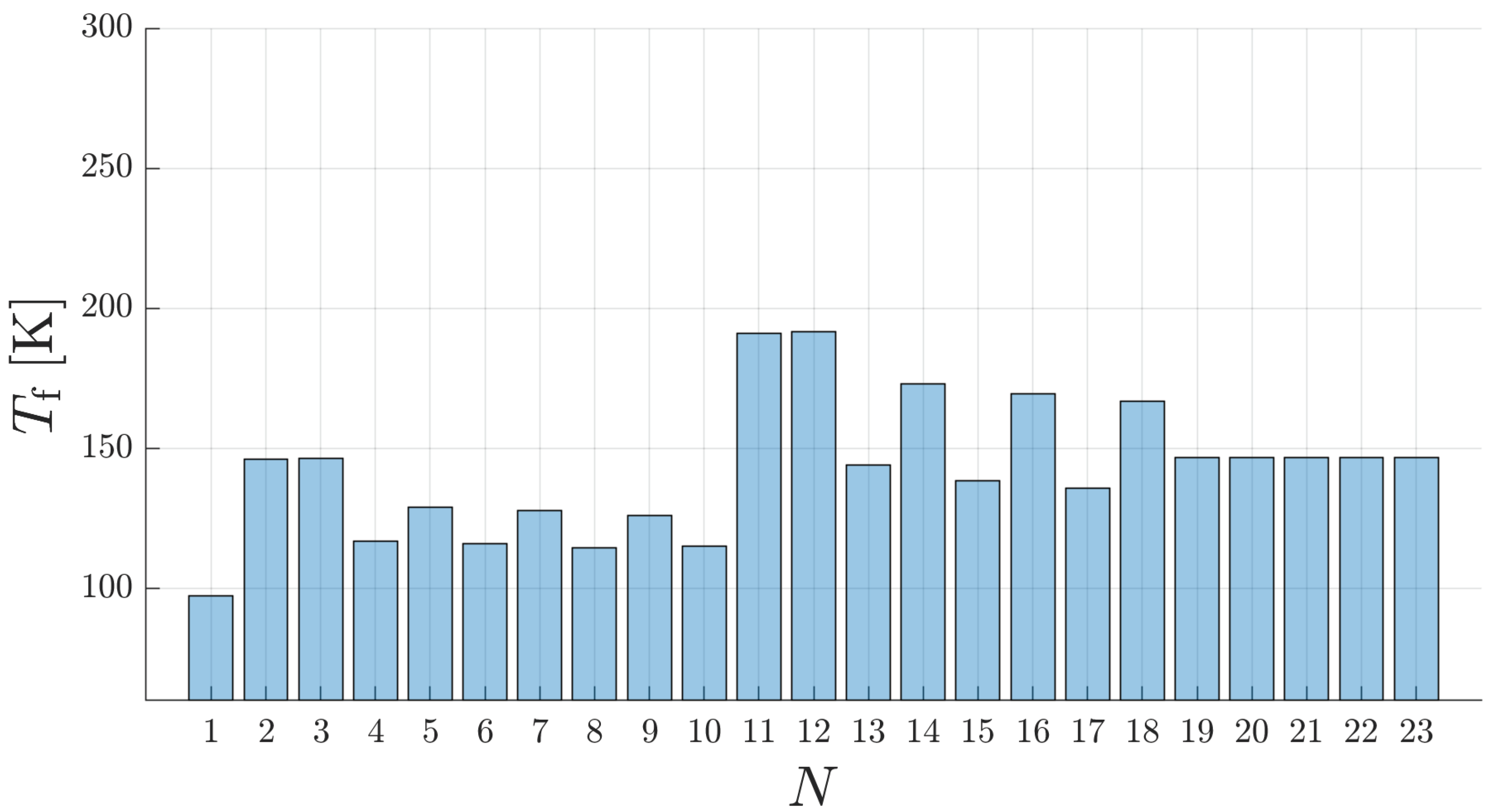


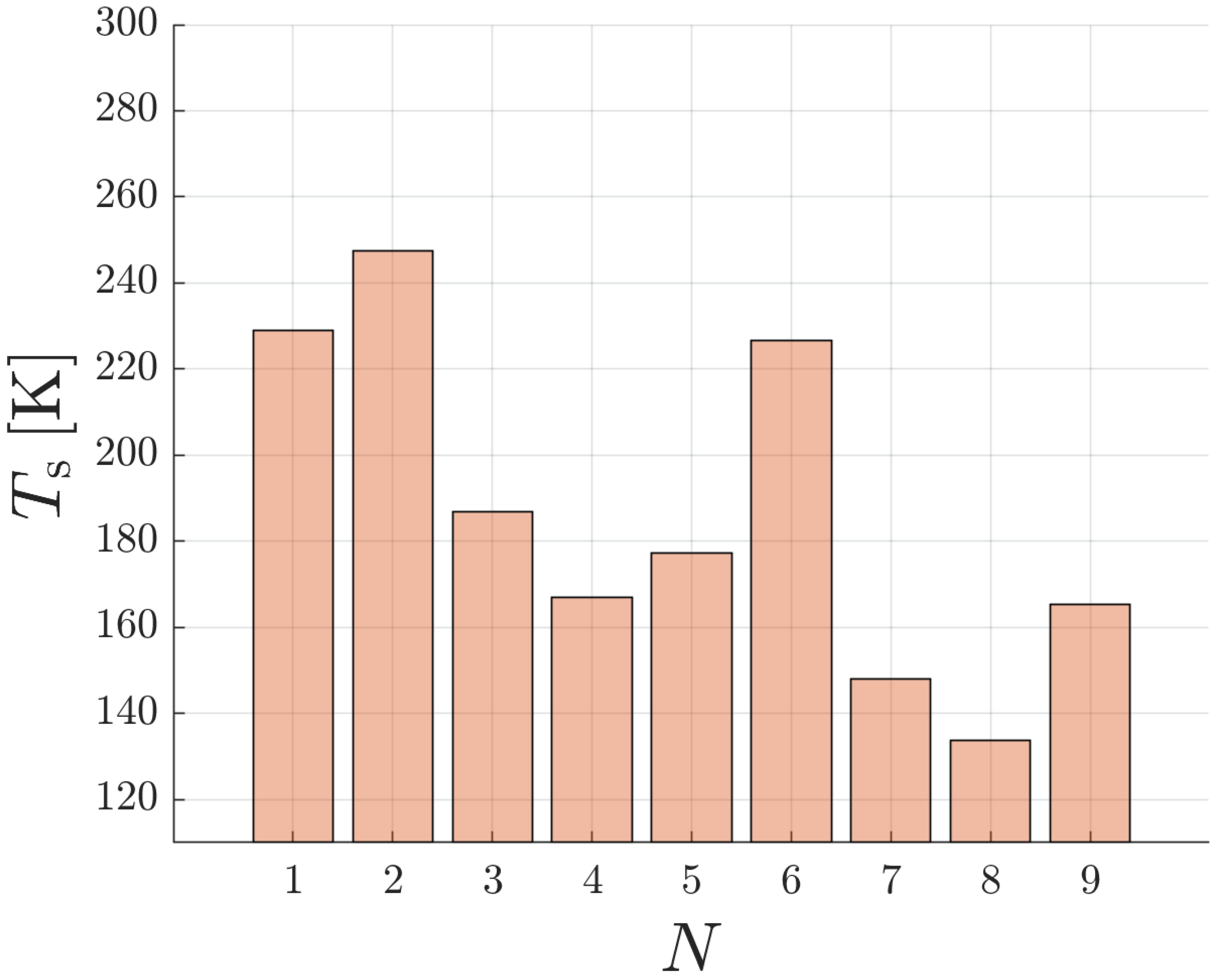
| State Variable | Governing Equation |
|---|---|
| Species masses | Mass conservation equations (Equation (1)) |
| Flow rate | Momentum conservation equations (Equation (2)) |
| Fluid enthalpy | Energy conservation equations of fluid (Equation (3)) |
| Species enthalpies | Energy equations of fluid (Equation (17)) |
| Wall temperature | Energy conservation equations of solid (Equation (4)) |
| Pressure | Thermodynamic state (Equation (19)) |
| Boundary Conditions | ||||||
|---|---|---|---|---|---|---|
| Test Case 1 | Test Case 2 | Test Case 3 | Test Case 4 | Test Case 5 | ||
| B1 | x | 0.150 | 0.150 | 0.150 | 0.150 | 0.150 |
| p | 0.197 | 0.209 | 0.213 | 0.212 | 0.221 | |
| 9.890 | 9.890 | 9.890 | 9.890 | 9.890 | ||
| Fluid | Oxygen | |||||
| B2 | T | 270.95 | 274.930 | 276.83 | 278.27 | 279.60 |
| p | 1.151 | 1.291 | 1.393 | 1.504 | 1.600 | |
| 1.590 | 1.850 | 2.060 | 2.250 | 2.460 | ||
| Fluid | Helium | |||||
| B3 | T | 288.10 | 288.500 | 288.75 | 288.98 | 289.43 |
| p | 1.137 | 1.276 | 1.377 | 1.486 | 1.582 | |
| 3.190 | 3.710 | 4.110 | 4.510 | 4.920 | ||
| Fluid | Helium | |||||
| N23 | p | 0.197 | 0.209 | 0.213 | 0.212 | 0.221 |
| N39 | p | 1.151 | 1.291 | 1.393 | 1.504 | 1.600 |
| Results | ||||||
|---|---|---|---|---|---|---|
| Test Case 1 | Test Case 2 | Test Case 3 | Test Case 4 | Test Case 5 | ||
| He/LOx Drain | 187.01 | 205.06 | 215.12 | 223.00 | 229.36 | |
| - | 191.04 | 199.61 | 205.14 | 209.62 | 213.97 | |
| Probe A | −2.15 | 2.65 | 4.63 | 5.99 | 6.70 | |
| He/LOx Drain | 165.58 | 181.12 | 188.81 | 194.13 | 198.59 | |
| - | 166 | 178.18 | 185.18 | 191.03 | 196.83 | |
| Probe B | −0.81 | 1.61 | 1.92 | 1.59 | 0.88 | |
| He Inlet | 270.95 | 274.93 | 276.83 | 278.27 | 279.60 | |
| - | 265.71 | 268.90 | 270.86 | 272.49 | 274.21 | |
| Probe C | 1.93 | 2.19 | 2.15 | 2.07 | 1.92 | |
| He Inlet | 250.53 | 257.52 | 260.62 | 263.06 | 265.31 | |
| - | 245.14 | 250.89 | 254.36 | 257.25 | 260.15 | |
| Probe D | 2.14 | 2.57 | 2.40 | 2.20 | 1.94 | |
Publisher’s Note: MDPI stays neutral with regard to jurisdictional claims in published maps and institutional affiliations. |
© 2022 by the authors. Licensee MDPI, Basel, Switzerland. This article is an open access article distributed under the terms and conditions of the Creative Commons Attribution (CC BY) license (https://creativecommons.org/licenses/by/4.0/).
Share and Cite
Maritano, L.; Marin, F.M.; Bertani, C.; Pastrone, D.; Angelucci, M.; Caggiano, G. Numerical Prediction of Internal Flows in He/LOx Seals for Liquid Rocket Engine Cryogenic Turbopumps. Appl. Sci. 2022, 12, 10776. https://doi.org/10.3390/app122110776
Maritano L, Marin FM, Bertani C, Pastrone D, Angelucci M, Caggiano G. Numerical Prediction of Internal Flows in He/LOx Seals for Liquid Rocket Engine Cryogenic Turbopumps. Applied Sciences. 2022; 12(21):10776. https://doi.org/10.3390/app122110776
Chicago/Turabian StyleMaritano, Lorenzo, Francesco Maria Marin, Cristina Bertani, Dario Pastrone, Maddalena Angelucci, and Giuseppe Caggiano. 2022. "Numerical Prediction of Internal Flows in He/LOx Seals for Liquid Rocket Engine Cryogenic Turbopumps" Applied Sciences 12, no. 21: 10776. https://doi.org/10.3390/app122110776
APA StyleMaritano, L., Marin, F. M., Bertani, C., Pastrone, D., Angelucci, M., & Caggiano, G. (2022). Numerical Prediction of Internal Flows in He/LOx Seals for Liquid Rocket Engine Cryogenic Turbopumps. Applied Sciences, 12(21), 10776. https://doi.org/10.3390/app122110776







